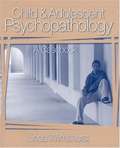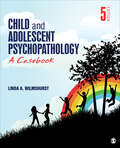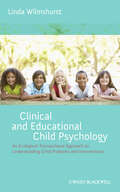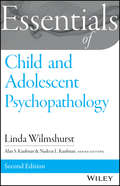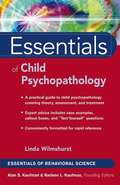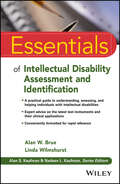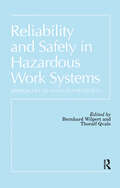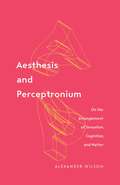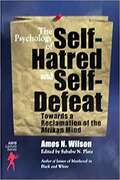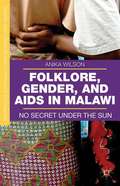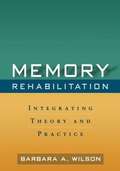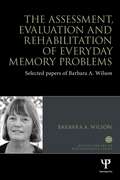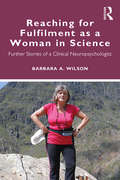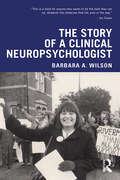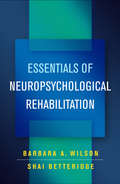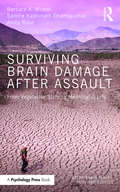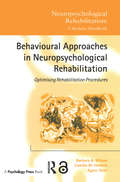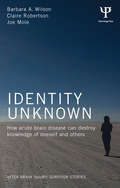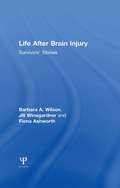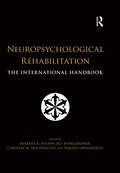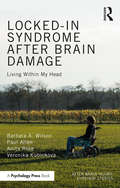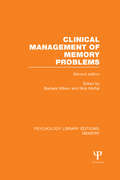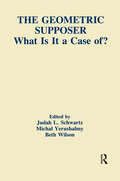- Table View
- List View
Child & Adolescent Psychopathology
by Linda WilmshurstChild and Adolescent Psychopathology: A Casebook provides an abundance of realistic cases in assessing and treating child psychopathologies. Students are first introduced to "A Case Called Jeremy," a six-year-old hyperactive and non-compliant child raised by his mother and maternal grandmother. Using Jeremy as a guide, students are exposed to a three-stage model of case formulation, and gain an awareness of the competencies and knowledge required to successfully accomplish the goals of each stage in the process. Developing case formulations for Jeremy based on different theoretical perspectives, students gain an increased appreciation of how case formulations evolve based on five different theoretical perspectives: psychodynamic, behavioral, cognitive, family systems, and attachment/parenting. In part two, fourteen cases present dynamic illustrations of the complex and comorbid nature of childhood disorders. Each case is accompanied by a discussion of relevant evidence-based treatments and provocative questions designed to link case-based information to theory and research. Supplemental information provided in the Appendix will be of particular interest to advanced students in child assessment and child treatment. Child and Adolescent Psychopathology: A Casebook is an excellent supplement for advanced undergraduate and graduate courses in developmental psychology, child psychology, counseling, and education. Practicing clinicians will also find this an invaluable reference in the assessment and treatment of child psychopathologies.
Child and Adolescent Psychopathology: A Casebook
by Linda WilmshurstChild and Adolescent Psychopathology: A Casebook, Fifth Edition provides students with an opportunity to gain deeper insight into a wide range of disorders within the context of the diagnostic framework of the DSM-5. This supplemental textbook provides an abundance of "real life" cases which demonstrate methods in assessing and treating a wide spectrum of child and adolescent psychopathologies in a variety of settings. Each case presents an opportunity to practice and develop clinical skills in the assessment, diagnosis, and treatment of childhood disorders from a number of theoretical perspectives and at various levels of interest and expertise. The book features current trends in assessment, diagnosis, treatment, and research. It is an ideal hands-on resource for a child and adolescent psychopathology course. The Fifth Edition includes a new case study on depression, expanded coverage of trauma-related disorders, a new glossary, and updated assessment materials and references throughout.
Child and Adolescent Psychopathology: A Casebook
by Linda WilmshurstChild and Adolescent Psychopathology: A Casebook, Fifth Edition provides students with an opportunity to gain deeper insight into a wide range of disorders within the context of the diagnostic framework of the DSM-5. This supplemental textbook provides an abundance of "real life" cases which demonstrate methods in assessing and treating a wide spectrum of child and adolescent psychopathologies in a variety of settings. Each case presents an opportunity to practice and develop clinical skills in the assessment, diagnosis, and treatment of childhood disorders from a number of theoretical perspectives and at various levels of interest and expertise. The book features current trends in assessment, diagnosis, treatment, and research. It is an ideal hands-on resource for a child and adolescent psychopathology course. The Fifth Edition includes a new case study on depression, expanded coverage of trauma-related disorders, a new glossary, and updated assessment materials and references throughout.
Clinical and Educational Child Psychology
by Linda WilmshurstClinical and Educational Child Psychology: An Ecological-Transactional Approach to Developmental Problems and Interventions explores developmental milestones in early childhood and adolescence and provides intervention strategies in both clinical and educational contexts. Currently one of the only books on child psychopathology that is up to date with recently-released DSM-V standards Explores how challenges commonly encountered at ages 3-18 can influence development Draws on contemporary research on the developing brain to show why some children may be vulnerable to a host of clinical and educational problems Equips readers to develop case formulations and interventions in a holistic way Discusses developmental milestones and adjustment disorders in both early childhood and adolescence
Essentials of Child and Adolescent Psychopathology (Essentials of Behavioral Science)
by Linda WilmshurstA concise guide to the fundamentals of child psychopathology, complete with the latest developments Essentials of Child and Adolescent Psychopathology, Second Edition provides a concise, accessible overview of the major theories, assessment practices, and key issues. This updated Second Edition describes the significant changes in the way DSM -5 conceptualizes disorders in children and adolescents, and includes a new chapter on child abuse, child maltreatment, and self-injurious behavior. Using practical case examples to illustrate key points, the book addresses specific disorders and problems prevalent among this age group—including anxiety, mood disorders, and traumatic stress. Each chapter features reader-friendly elements like Rapid Reference, Caution, and Don't Forget boxes that call out important information, facilitating easy look-up and quick navigation. This invaluable resource fills the need for an overview of the most current issues and changes in the field, allowing readers to: Review the development, theories, and influences in child and adolescent psychopathology Understand neurodevelopmental disorders including intellectual and developmental disabilities, ADHD, and specific learning disabilities or disorders Compare and contrast the manifestations of internalized vs. externalized disorders Examine later-onset disorders and special topics including eating disorders, substance abuse, and trauma-related disorders The book also includes appendices on ethical conduct, assessment instruments, and IDEA 2004, providing readers the guidance and tools that can help increase positive outcomes. Whether used as a secondary text or as a professional reference, Essentials of Child and Adolescent Psychopathology, Second Edition provides an authoritative briefing on this evolving area of practice.
Essentials of Child Psychopathology
by Linda WilmshurstThe only concise, comprehensive overview of child psychopathology covering theory, assessment, and treatment as well as issues and trends Essentials of Child Psychopathology provides students and professionals with a comprehensive overview of critical conceptual issues in child and adolescent psychopathology. The text covers the major theories, assessment practices, issues, and trends in this important field. Author Linda Wilmshurst also includes chapters on specific disorders prevalent among this age group and covers special topics such as diversity, abuse, and divorce. As part of the Essentials of Behavioral Science series, this book provides information mental health professionals need in order to practice knowledgeably, efficiently, and ethically in today's behavioral healthcare environment. Each concise chapter features numerous callout boxes highlighting key concepts, bulleted points, and extensive illustrative material, as well as "Test Yourself" questions that help you gauge and reinforce your grasp of the information covered. Essentials of Child Psychopathology is the only available resource to condense the wide-ranging topics of the field into a concise, accessible format for handy and quick reference. An excellent review guide, Essentials of Child Psychopathology is an invaluable tool for learning as well as a convenient reference for established mental health professionals. Other titles in the Essentials of Behavioral Science series: * Essentials of Statistics for the Social and Behavioral Sciences * Essentials of Psychological Testing * Essentials of Research Design and Methodology
Essentials of Intellectual Disability Assessment and Identification
by Linda Wilmshurst Alan W BrueA concise, up-to-date overview of intellectual disability evaluation and assessment Essentials of Intellectual Disability Assessment and Identification offers a practical, concise overview of the nature of intellectual disability and adaptive skills functioning in children, adolescents, and adults. Coverage includes the latest information on prevalence, causes, differential diagnoses, behavioral and social concerns, test instruments, and the new DSM-5 diagnostic criteria. The discussion promotes a deeper understanding of the use of assessment data to inform interventions in clinical practice. Designed for easy navigation, each chapter highlights important points and key cautions to allow quick reference without sacrificing depth. A sample assessment report illustrates how findings should be communicated to better inform treatment, giving you a practical reference to ensure comprehensive reporting. In 2013, the DSM-5 conceptualization of intellectual disabilities was significantly changed. It's important for professionals to have access to the most current guidelines from a variety of sources, and this book compiles them all into a single reference. Understand the goals of assessment in terms of treatment and intervention Delve into the legal issues resulting from the changes in diagnostic criteria Provide feedback to parents and caregivers of intellectually disabled individuals Learn the unique clinical applications of each assessment instrument Understanding which test to use is not enough; students and professionals need a more comprehensive view of intellectual disabilities, informed by the most up-to-date body of knowledge available. Essentials of Intellectual Disability Assessment and Identification gives you the knowledge base and skill set you need for effective evaluation and assessment.
Reliability and Safety In Hazardous Work Systems: Approaches To Analysis And Design
by Bernhard Wilpert Thoralf QvaleThis volume contains a selection of original contributions from internationally reputed scholars in the field of risk management in socio?technical systems with high hazard potential. Its first major section addresses fundamental psychological and socio?technical concepts in the field of risk perception, risk management and learning systems for safety improvement. The second section deals with the variety of procedures for system safety analysis. It covers strategies of analyzing automation problems and of safety culture as well as the analysis of social dynamics in field settings and of field experiments. Its third part then illustrates the utilization of basic concepts and analytic approaches by way of case studies of designing man?machine systems and in various industrial sectors such as intensive care wards, aviation, offfshore oil drilling and chemical industry. In linking basic theoretical conceptual notions and analytic strategies to detailed case studies in the area of hazardous work organizations the volume differs from and complements more theoretical works such as Human Error (J. Reason, 1990) and more general approaches such as New Technologies and Human Error (J. Rasmussen, K. Duncan, J. Leplat, Eds.)
Aesthesis and Perceptronium: On the Entanglement of Sensation, Cognition, and Matter (Posthumanities #51)
by Alexander WilsonA new speculative ontology of aesthetics In Aesthesis and Perceptronium, Alexander Wilson presents a theory of materialist and posthumanist aesthetics founded on an original speculative ontology that addresses the interconnections of experience, cognition, organism, and matter. Entering the active fields of contemporary thought known as the new materialisms and realisms, Wilson argues for a rigorous redefining of the criteria that allow us to discriminate between those materials and objects where aesthesis (perception, cognition) takes place and those where it doesn’t. Aesthesis and Perceptronium negotiates between indiscriminately pluralist views that attribute mentation to all things and eliminative views that deny the existence of mentation even in humans. By recasting aesthetic questions within the framework of “epistemaesthetics,” which considers cognition and aesthetics as belonging to a single category that can neither be fully disentangled nor fully reduced to either of its terms, Wilson forges a theory of nonhuman experience that avoids this untenable dilemma. Through a novel consideration of the evolutionary origins of cognition and its extension in technological developments, the investigation culminates in a rigorous reevaluation of the status of matter, information, computation, causality, and time in terms of their logical and causal engagement with the activities of human and nonhuman agents.
The Psychology Of Self-hatred And Self-defeat: Towards A Reclamation Of The Afrikan Mind
by Amos N. Wilson Sababu N. PlataThe Psychology of Self-Hatred and Self-Defeat: Towards a Reclamation of the Afrikan Mind
Folklore, Gender, And Aids In Malawi
by Anika WilsonInformal folk narrative genres such as gossip, advice, rumor, and urban legends provide a unique lens through which to discern popular formations of gender conflict and AIDS beliefs. This is the first book on AIDS and gender in Africa to draw primarily on such narratives. By exploring tales of love medicine, gossip about romantic rivalries, rumors of mysterious new diseases, marital advice, and stories of rape, among others, it provides rich, personally grounded insights into the everyday struggles of people living in an era marked by social upheaval.
Memory Rehabilitation
by Barbara WilsonFrom a well-known authority, this comprehensive yet accessible book shows how state-of-the-art research can be applied to help people with nonprogressive memory disorders improve their functioning and quality of life. Barbara Wilson describes a broad range of interventions, including compensatory aids, learning strategies, and techniques for managing associated anxiety and stress. She reviews the evidence base for each clinical strategy or tool and offers expert guidance on how to assess patients, set treatment goals, develop individualized rehabilitation programs, and conduct memory groups. The book also provides essential background knowledge on the nature and causes of memory impairment.
The Assessment, Evaluation and Rehabilitation of Everyday Memory Problems: Selected papers of Barbara A. Wilson (World Library of Psychologists)
by Barbara A. WilsonIn the World Library of Psychologists series, international experts present career-long collections of what they judge to be their finest work—extracts from books, key articles, salient research findings and their major theoretical and practical contributions. This volume of self-selected papers recognises Professor Barbara A. Wilson's major contribution to the study of neuropsychology. Published over a 25-year period, the papers included here address the assessment, treatment and evaluation of rehabilitation provided to people who have memory difficulties arising from an injury or illness affecting the brain. This selection of papers includes work on errorless learning, the natural history of the development of compensatory memory systems, paging systems developed to enhance independent daily living for memory impaired people and single-case experimental designs to appraise the response of individual patients. The final section includes a practical framework for understanding compensatory behaviour, a model of cognitive rehabilitation and a discussion of the dilemmas created by the different aims of neuroscience as opposed to those of clinicians. This book will be of great interest to clinical psychologists, neuropsychologists, occupational therapists and speech and language therapists, along with anyone who is interested in reducing the impact of memory problems on people who have suffered brain injury.
Reaching for Fulfilment as a Woman in Science: Further Stories of a Clinical Neuropsychologist
by Barbara A. WilsonThis vivid memoir presents adventures from the life of Barbara A. Wilson, an internationally honoured scientist who played an influential role in the development of neuropsychological rehabilitation at a time when the scientific field was dominated by men. As a follow-up to the highly successful Story of a Clinical Neuropsychologist, this book includes a host of memories, both personal and professional, which focus on Barbara’s development of her career as a woman in science. From childhood recollections and travels in Africa, to lifetime achievement awards and the restrictions of global pandemics, Barbara tells the story of her full and varied life and her unparalleled career in neuropsychological rehabilitation. Her book indicates that one can lead a meaningful and full life even after one of the most awful of losses, the death of a child, and also emphasizes the need to stick to one’s principles in trying times. The result is an unparalleled insight into the life of a clinical neuropsychologist, which can encourage the next generation of professionals who are trying to balance career, international travel and family, as well as inspire any girls interested in entering the world of science.
The Story of a Clinical Neuropsychologist
by Barbara A. WilsonFrom a disadvantaged childhood to becoming one of our best-loved clinical neuropsychologists, this exceptional book tells the life story of Barbara A. Wilson, who has changed the way we think about brain injury rehabilitation. Barbara’s story shows how it is possible to have a fulfilling career alongside a successful family life, even when faced with the deepest of personal tragedies; the death of her adult daughter Sarah. Clinical and neuropsychologists will recognise Barbara’s influence on rehabilitation practice and her tireless aim to get what is best for people needing neuropsychological rehabilitation. It will inspire those with brain injury and their families who may struggle to make life meaningful, as well as encourage readers to stick to their beliefs and triumph in the face of obstacles.
Essentials of Neuropsychological Rehabilitation
by Barbara A. Wilson Shai BetteridgeFor people with disabilities caused by nonprogressive brain injury, challenges in everyday living can be multifaceted and overwhelming. This book presents key principles of holistic neuropsychological rehabilitation, helping practitioners stay on track through complex terrain. Leading authorities Barbara A. Wilson and Shai Betteridge provide a framework for effective intervention based on a collaborative understanding of clients' strengths and needs. They describe essential strategies for assessing and remediating the impact of cognitive and psychosocial problems in everyday life. Detailed case examples illustrate the process of building partnerships with families, setting meaningful goals, developing skills and supports, and addressing emotional and mental health concerns. Innovative uses of technology are highlighted. Several reproducible clinical tools can be downloaded and printed in a convenient 8 1/2" x 11" size.
Surviving Brain Damage After Assault: From Vegetative State to Meaningful Life (After Brain Injury: Survivor Stories)
by Barbara A. Wilson Samira Kashinath Dhamapurkar Anita RoseAt the age of twenty eight Gary was assaulted by a gang with baseball bats and a hammer, resulting in several skull fractures and severe brain damage. For nineteen months he had little awareness of his surroundings before he started to show some recovery. This inspirational book documents his exceptional journey. The book presents a series of interviews with Gary, his mother Wendie, who never gave up, the medical team who initially treated him, and the therapists who worked with him over a period of three years. Through their testimony we learn about the devastating effects which can follow a serious assault to the head, and the long process of recovery over several years. With specialist rehabilitation and continuing family support Gary has exceeded expectations and, apart from some minor physical problems, he is now a normal young man. Surviving Brain Damage after Assault shows that, contrary to popular belief, considerable gains can be made by people who have experienced a long period of reduced consciousness. The book will be of great value to all professionals working in rehabilitation - psychologists, speech and language therapists, occupational therapists, social workers and rehabilitation doctors, and to people who have sustained a brain injury and their families.
Neuropsychological Rehabilitation
by Barbara A. Wilson Fergus Gracey Jonathan J. Evans Andrew BatemanAfter an introduction to the current theories and research findings related to brain injury rehabilitation, this text presents 20 case studies of adults who sustained severe brain damage caused by traumatic head injuries, encephalitis, stroke, hypoxia and other conditions. Problems that follow such injuries are analyzed in detail; these include loss of self-care skills, memory impairment, and language, reading, visuoperceptual and behavioral difficulties. The chapters describe the lifestyle of each individual before the onset of brain damage and the subsequent symptoms, neuropsychological assessment, rehabilitation, and long-term outcome of their condition. Most chapters include a report by the patient and/or family member, thus enhancing the reader's understanding of the predicaments faced by brain-injured individuals as they learn to cope with traumatic changes in lifestyle. Although improvement for those with severe brain injuries is slow and limited, the patients described in the book made some progress after their admission to rehabilitation services. The exhaustive analysis of each case and a step-by-step description of management will serve as an inspiring and informative guide for students, professionals and other caregivers.
Behavioural Approaches in Neuropsychological Rehabilitation: Optimising Rehabilitation Procedures (Neuropsychological Rehabilitation: A Modular Handbook)
by Barbara A. Wilson Camilla M. Herbert Agnes ShielThe potential of behavioural approaches for improving the lives of people with acquired brain injury is immense. Here that potential is laid out and explored with a thoroughgoing regard for clinical practice and the theoretical frameworks that underpin that practice. This book will prove an invaluable resource for clinical psychologists and the whole range of therapists working with patients suffering from acquired brain damage.
Identity Unknown: How acute brain disease can destroy knowledge of oneself and others (After Brain Injury: Survivor Stories)
by Barbara A. Wilson Claire Robertson Joe MoleImagine being unable to recognise your spouse, your children, or even yourself when you look in the mirror, despite having good eyesight and being able to read well and name objects. This is a condition which, in rare cases, some brain injury survivors experience every day. Identity Unknown gives an exceptional, poignant and in-depth understanding of what it is like to live with the severe after-effects of brain damage caused by a viral infection of the brain. It tells the story of Claire, a nurse, wife, and mother of four, who having survived encephalitis, was left with an inability to recognise faces – a condition also known as prosopagnosia together with a loss of knowledge of people and more general loss of semantic memory Part One describes our current knowledge of encephalitis, of perception and memory, and the theoretical aspects of prosopagnosia and semantic memory. Part Two, told in Claire’s own words, is an account of her life before her illness, her memories of the early days in hospital, an account of the treatment she received at the Oliver Zangwill Centre, and her description of the long-term consequences of encephalitis. Claire’s profound insights, clear writing style, and powerful portrayal of her feelings provide us with a moving insider’s view of her condition. These chapters also contain additional commentary from Barbara Wilson, providing further detail about the condition, treatment possibilities, potential outcomes, and follow-up options. Identity Unknown provides a unique personal insight into a condition which many of us have, for too long, known too little about. It will be of great interest to a broad audience including professionals working in rehabilitation settings, and all those who have sustained a brain injury, their families and carers.
Life After Brain Injury: Survivors' Stories (After Brain Injury: Survivor Stories)
by Barbara A. Wilson Jill Winegardner Fiona AshworthThis is the first book of its kind to include the personal accounts of people who have survived injury to the brain, along with professional therapists' reports of their progress through rehabilitation. The paintings and stories of survivors combine with experts' discussions of the theory and practice of brain injury rehabilitation to illustrate the ups and downs that survivors encounter in their journey from pre-injury status to insult and post-injury rehabilitation. Wilson, Winegardner and Ashworth's focus on the survivors' perspective shows how rehabilitation is an interactive process between people with brain injury, health care staff, and others, and gives the survivors the chance to tell their own stories of life before their injury, the nature of the insult, their early treatment, and subsequent rehabilitation. Presenting practical approaches to help survivors of brain injury achieve functionally relevant and meaningful goals, Life After Brain Injury: Survivors’ Stories will help all those working in rehabilitation understand the principles involved in holistic brain injury rehabilitation and how these principles, combined with theory and models, translate into clinical practice. This book will be of great interest to anyone who wishes to extend their knowledge of the latest theories and practices involved in making life more manageable for people who have suffered damage to the brain. Life After Brain Injury: Survivors’ Stories will also be essential for clinical psychologists, neuropsychologists, and anybody dealing with acquired brain injury whether they be a survivor of a brain injury themselves, a relative, a friend or a carer.
Neuropsychological Rehabilitation: The International Handbook (Studies On Neuropsychology, Neurology And Cognition Ser.)
by Barbara A. Wilson Jill Winegardner Caroline M. van Heugten Tamara OwnsworthThis outstanding new handbook offers unique coverage of all aspects of neuropsychological rehabilitation. Compiled by the world’s leading clinician-researchers, and written by an exceptional team of international contributors, the book is vast in scope, including chapters on the many and varied components of neuropsychological rehabilitation across the life span within one volume. Divided into sections, the first part looks at general issues in neuropsychological rehabilitation including theories and models, assessment and goal setting. The book goes on to examine the different populations referred for neuropsychological rehabilitation and then focuses on the rehabilitation of first cognitive and then psychosocial disorders. New and emerging approaches such as brain training and social robotics are also considered, alongside an extensive section on rehabilitation around the world, particularly in under-resourced settings. The final section offers some general conclusions and an evaluation of the key issues in this important field. This is a landmark publication for neuropsychological rehabilitation. It is the standalone reference text for the field as well as essential reading for all researchers, students and practitioners in clinical neuropsychology, clinical psychology, occupational therapy, and speech and language therapy. It will also be of great value to those in related professions such as neurologists, rehabilitation physicians, rehabilitation psychologists and medics.
Locked-in Syndrome after Brain Damage: Living within my head (After Brain Injury: Survivor Stories)
by Barbara Wilson Paul Allen Anita Rose Veronika KubickovaThe newest title in the series Survivor Stories, this book tells the story of Paul Allen, a photographer who likes opera and was a good baritone singer. At the age of 56 he sustained a stroke that left him paralysed and speechless. He has Locked-In Syndrome (LIS), a rare consequence of brain damage. Although Paul is fully conscious and his cognitive abilities are intact, he is unable to move or speak due to the paralysis of nearly all his voluntary muscles. However, Paul is keen to communicate and through his eye movements he tells his story, from his early life, career, singing and other interests, to the details of his stroke and the effects it has had on his life. The book also includes contributions from Paul’s wife Liz, who tells the story from her point of view, along with Paul’s physiotherapists, occupational therapists, speech therapists, psychologists and others from the Raphael Hospital who have assisted in Paul’s rehabilitation. In telling of his frustrations, his successes, his views on life and how he sees his future, Paul raises awareness of the quality of life possible for those with LIS. Combining scientific knowledge with personal narrative, this unique and optimistic book is of huge importance to any professional involved in the care of someone with a brain injury, and to the individuals and families touched by LIS.
Clinical Management of Memory Problems (Psychology Library Editions: Memory)
by Barbara Wilson Nick MoffatMany patients with stroke, head injuries or dementia suffer severe memory impairment and in many cases improvement may fail to occur. This book, first published in 1984 followed by this second edition in 1992, offers practical guidelines to the problems and is supported by a discussion of theory about memory systems and functioning. It should enable therapists and psychologists to recognize, understand, assess and manage memory problems arising from injury, accident or infection of the brain. The authors are well-known for their interest in memory and memory therapy. Topics covered in this text include: the relationship between memory and practice, assessment, methods for improving memory, organization of memory therapy, selection of appropriate treatments for individual patients, role of the microcomputer in memory rehabilitation, use of drugs in stimulating memory, development of programmes to improve attention and the treatment of the memory-impaired in groups. This second edition has an update on drugs, electronic aids and assessment procedures, with further evidence of the effectiveness of memory therapy. This book would have been an asset for those professionals involved in the rehabilitation of the impaired memory at the time and can still be of value today.
The Geometric Supposer: What Is It A Case Of? (Technology and Education Series)
by Beth Wilson Judah L. Schwartz Michal YerushalmyThis volume is a case study of education reform and innovation using technology that examines the issue from a wide variety of perspectives. It brings together the views and experiences of software designers, curriculum writers, teachers and students, researchers and administrators. Thus, it stands in contrast to other analyses of innovation that tend to look through the particular prisms of research, classroom practice, or software design. The Geometric Supposer encourages a belief in a better tomorrow for schools. On its surface, the Geometric Supposer provides the means for radically altering the way in which geometry is taught and the quality of learning that can be achieved. At a deeper level, however, it suggests a powerful metaphor for improving education that can be played out in many different instructional contexts.
